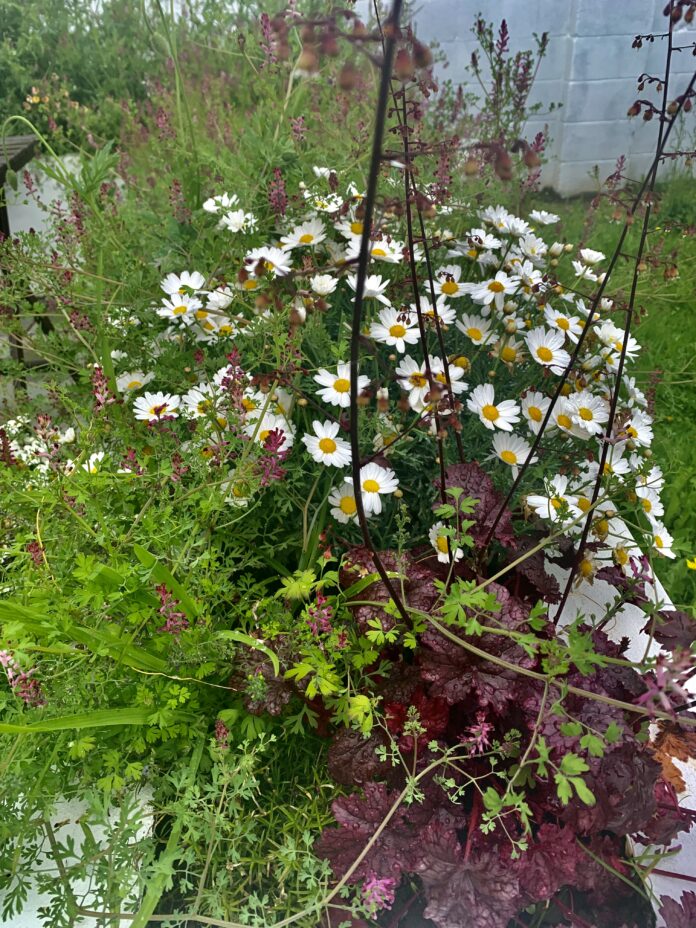Noeleen Smyth thinks we should take the Chelsea Flower Show’s lead and just let it grow!.
Having trained in both horticulture at Teagasc National Botanic Gardens and the RHS UK, and in botany at TCD Dublin, sometimes reconciling both parts of myself and my overall worldview regarding plants can be challenging.
I’ve discovered that when I’m in a garden, I’m drawn towards the more exotic. I am loving the new fern and flowerless plants displayed at the National Botanic Gardens. They bring very exotic Cycads from the great palm house out for a bit of an Irish summer holiday. However, when I’m out in wilder places, on the fringes of our urban and rural gardens – such as the Special Area of Conservation on Howth Head or walking by the road verge – I hate seeing garden exotics and exotic hardy annuals, often sold as “wildflower mixes”, mingling in. I am clear in how I feel about garden plants in the wild, but how do I feel about the wild in the garden?
The wild is a big trend, and not unsurprisingly, as along with other countries we have declared a biodiversity emergency. Our plants and animals are under increasing threat of extinction along with our wild habitats and landscapes. Pollinators, in particular, and the shocking demise of our bee species have raised our concerns into action. Indeed, plenty of excellent guidance for managing and planting in various situations exists on the All Ireland Pollinator Plan Website (pollinators.ie).
That bastion of horticultural excellence, The Chelsea Flower Show encouraged us to embrace the wild side this year with the winning garden A Rewilding Britain Landscape, designed by Urquhart & Hunt. Here was an interpretation of the wild countryside of South West England, a landscape with beavers at the centre as ecological engineers. Here in Ireland, we had our own rustic landscape gold winner at Bloom: the Sustainable Dairy Farm Garden by Sean Russell. Instead of the beaver at the centre we have a dairy cow. Both are interesting interpretations of a wilder theme.
Often, our vision of a wild landscape is in reality unindustrialised farmland. This farmland and its species rich grassland supports a large number of rare Irish species. It is one of our rarest Irish habitats. We have lost over 30% in just 6 years, known more formally as our EU annexed calcareous grassland and lowland hay meadows. Every piece of natural or semi-natural grassland with Irish wildflowers is precious to us and our pollinators, including the bees.
‘Control’ is at the centre of our definition of a garden. The rewilding garden at Chelsea left our gardening guru from the BBC, Monty Don, pondering the question, “Rewilding Britain was beautifully done, but was it a garden?” The wild inside sits a little funny with all of us. Are we afraid of that ‘loss of control’?
HOW WE CAN EMBRACE THE WILD AND NOT LOSE THE RUN OF OURSELVES
Managing our lawns and amenity grassland is a key place to start if we want to ‘go wild’. We can tend to our household, urban and suburban grasslands in ways that support Irish wild species and wildflowers, through reduced mowing. One of my favourite lines from a recent AIPP blog reads: “to humans, a neatly manicured lawn looks tidy, but … to our wildlife it must look like the apocalypse!”
There are two main ways to do this, depending on how wild you want to go. The wildest approach is to let the grass grow, mowing once in September and removing all the ‘hay’. It may not look great for the first few years, but it will build naturally and evermore wild flowers will appear. This is akin to how a farmer would have managed a hay meadow of old. An alternative version is a short flower meadow, which can be encouraged by mowing every six weeks and removing the grass. I take this approach with my very tiny patch of grass and am up to over 20 species of wild plants. Clovers, Daisys, dandelions, and buttercups all thrive and it looks and smells great on a sunny day.
Growing and planting Irish native trees is another way to go wild, and it’s great to see this happening and being encouraged more often in landscape schemes. One issue to be careful with here is ‘provenance’. Often, the species itself may be native, but the source for the propagation material may not be. The biggest example of this becoming a problem is Ash dieback. You can buy Ash Fraxinus excelsior anywhere and it is a lovely Irish tree species. A few years ago, when Irish nurseries ran out of Irish provenanced Ash, they imported a lot of Ash Fraxinus excelsior. The ash from abroad came with ash dieback and the devastating results can be seen clearly in our landscape on a daily basis.
To encourage Irish wildflowers in the garden, I do a version of leaving some space and ‘controlled weeding’. This means I stop anything that tries to overrun my favourites, but I happily leave most of them be. This might be a hard sell for lots of you, but look at the pictures, it’s not too bad eh?
As you can see, I have had some lovely plant combinations appear in small raised beds this year. I’ll seed and save the ones I like, to sprinkle again next year. One of my favourites that popped up this year was wild mustard, Sinapsis arvensis, which put on a spectacular display for most of April. I also love the crazy sprawling fumitory Fumaria capreolata with its fern-like and delicate foliage that can be seen threading through other flowers and foliage here with Heuchera and Argyranthemum. I’m very excited by a nice looking `rough poppy’ that has emerged. I’m hoping it’s the rare Papaver hybridium!
We are facing a future of managed landscapes. These places need to be managed to maintain life on our planet and the species diversity we need to survive, both plants and animals. We need large landscape sized seed stocks, rewilding of our native habitats, and we should also encourage supporting wild plants in our urban and managed environments through reduced mowing, reduced chemical and herbicide use, and relaxing our weeding styles.
A new category is emerging, maybe it’s not a garden monty, or a wild landscape, but a new place in between where we can just “let it grow”, a managed ecoscape, or semi-natural garden. ✽

Noeleen Smyth is an Assistant Professor in Envirmonmental Horticulture at University College Dublin. She holds a PhD. and Hons Degree in Botany from Trinity College Dublin and diplomas in Horticulture from Teagasc and RHS. She is a Biodiversity and conservation specialist. As part of her current role, she acts as the CITES Scientific Authority for Ireland, advising the government on rare plant imports. |






